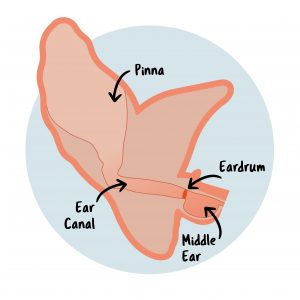Did you know that dogs are at much higher risk in hot weather than humans are? As a result, they can easily suffer heatstroke in hot weather (and it’s not always just in summer), becoming ill, or even fatal consequences from overheating.
Why don’t dogs cope well with the heat?
Humans can lose heat by sweating – as the water in sweat evaporates, we cool down. We also wear loose-fitting clothing, that acts as a barrier to the sun’s rays, and traps a layer of cooler air between us and the outside air.
Dogs, however, are descended from wolves – animals that are well adapted to live in cold, arctic countries. They only have sweat glands on the tip of their nose and on their pads, and their coats are designed to keep heat in, not out. As a result, they struggle to lose heat when their body temperature rises – the only way that they can cool down is by panting.
Why isn’t panting enough to stop them from getting overheated?
Panting works fairly well for a short time – but it uses up a lot of water. Sooner or later, the dog will become dehydrated and won’t be able to salivate anymore, then their temperature climbs rapidly and dangerously.
What effect does overheating have on the dog?
Well, firstly, it leads to dehydration – many dogs who die of heatstroke actually die of shock as their body becomes dehydrated, leading to the collapse of their circulatory system. However, in exceptionally hot weather, even well-hydrated dogs can die, as their body temperature climbs faster than they are able to lose heat.
In this situation, the high body temperature literally cooks their blood, brains, and internal organs, resulting in abnormal clotting, brain damage, multi-organ failure, and then death. While a dog’s normal temperature is about 38.5C, a core temperature of 41C can lead to permanent brain damage, and the higher it goes, the more severe the damage and the faster it occurs.
What are the major risk factors?
The biggest risk is hot weather, but of course, in the summer, it’s hot throughout much of the day! The other major risk is breed – short-nosed dogs like Pugs and Bulldogs find it much, much harder to pant effectively than their long-nosed cousins. This is because their short noses lead to long soft palates and narrow nostrils, restricting airflow.
Other important factors include lack of shade and lack of water. In the midday sun, in summer, dogs can become dangerously overheated in minutes if they cannot find shade. Exercise in the heat of the day is also a problem – the more a dog exercises, the more heat their body generates, so the faster they reach the danger zone.
Most dogs, with adequate water, can maintain their core temperature up to an air temperature of about 32C – in short-nosed breeds, however, even this may be a struggle, so you need to be extra vigilant.
So what are the symptoms of Heatstroke?
The most common symptoms include:
- Exceptionally heavy panting
- Serious drooling or (if they’re dehydrated) sticky, or even dry gums
- Lethargy or unusual drowsiness
- Wobbliness or difficulty balancing
- Abnormal behaviour
- Vomiting
- Collapse
- Muscle tremors, twitching, or seizures
What should I do if my dog seems to be overheating?
When treating heatstroke in dogs, it’s crucial to prioritize cooling them down immediately before contacting your vet. Immerse young, healthy dogs in cool water, while older dogs or those with underlying health issues should be doused in cool water and then fanned. Avoiding using wet towels, as they are less effective.
Once you begin the cooling process, contact your local Goddard veterinary practice, or if it’s after hours, reach out to the nearest Goddard veterinary 24-Hour Emergency Hospital for further guidance.
Can it be treated?
It depends on how severe it is – we will work to gradually reduce their temperature, and help to treat the dehydration and shock. However, in many cases there will be permanent brain or organ damage; sadly, most studies put the mortality rate at about 50%.
How can I keep my dog safe?
Prevention is the key! On a hot day…
- Always allow your dog access to shade
- Make sure your dog always has water available
- Keep at-risk dogs, especially short-nosed breeds, indoors out of the heat during the day
- Spray hot dogs with cool water before they become ill, to help them cool down
- NEVER leave a dog in a car, even in the shade as temperatures can rise to dangerous levels within minutes
- Exercise your dog in the early morning or late evening, when it’s cooler
- Watch out for the warning signs…


